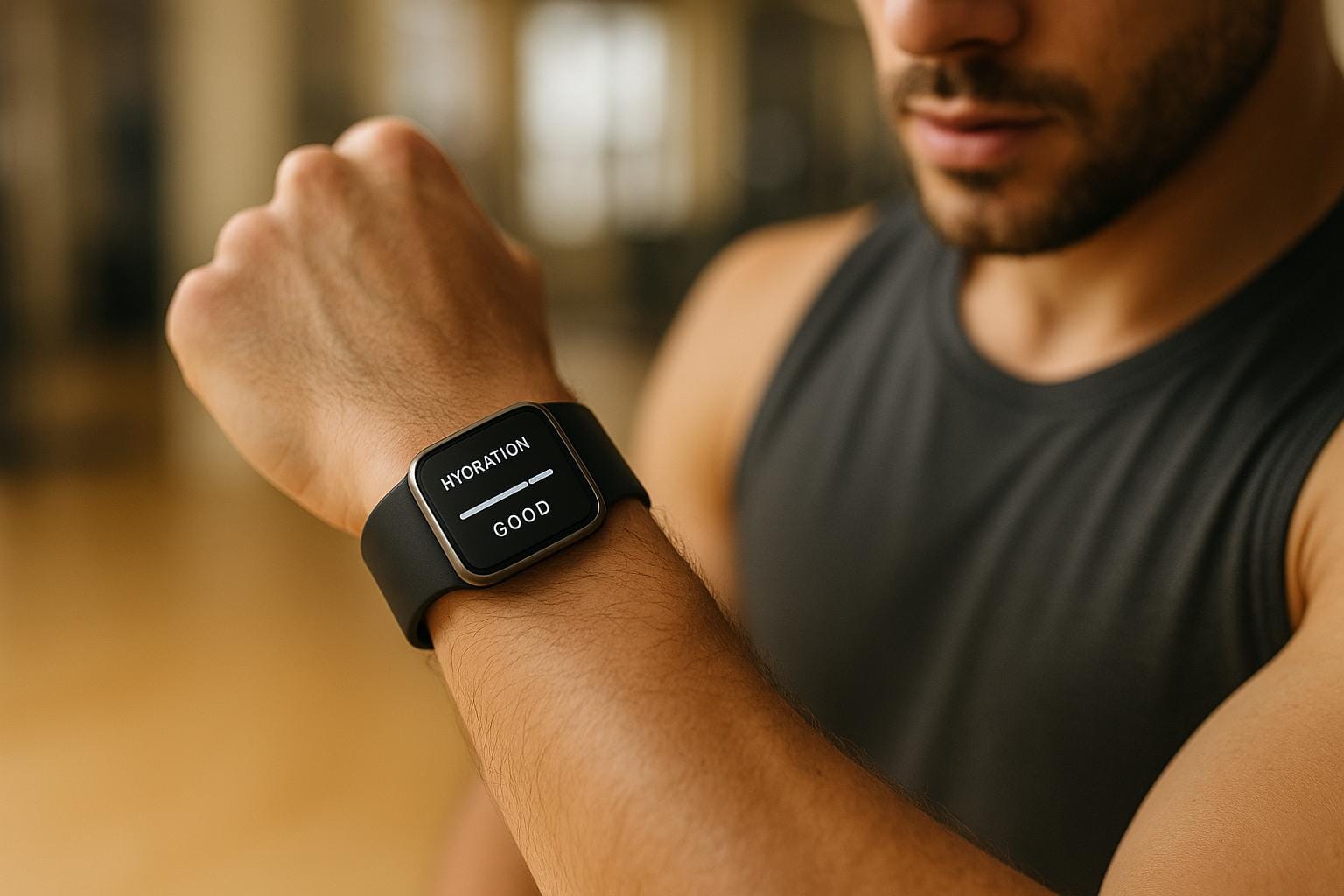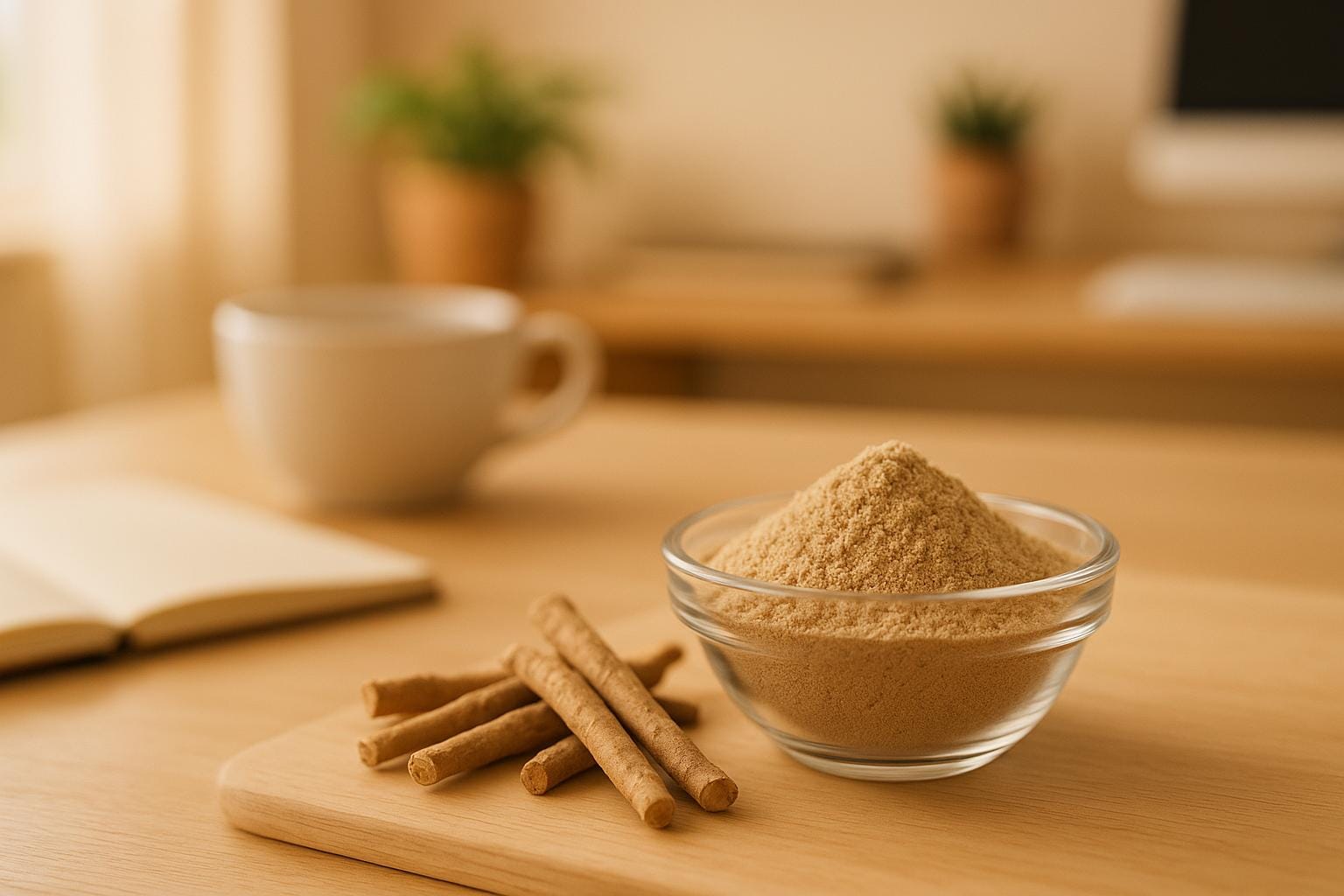VO2 max measures how much oxygen your body can use during intense exercise - a key indicator of fitness and cardiovascular health. Improving your VO2 max can enhance endurance, reduce fatigue, and even lower the risk of heart disease by up to 15%.
Quick Takeaways:
- What It Is: VO2 max is the maximum oxygen your body can use, measured in ml/kg/min.
- Why It’s Important: Strongly linked to fitness, longevity, and endurance. A 1 MET increase can reduce cardiovascular mortality by 13%.
- How to Improve It: High-intensity interval training (HIIT), endurance workouts, and hill repeats are the most effective methods.
- How to Measure It: Options include precise lab tests, field tests (like the Cooper Test), or estimates from fitness trackers.
Methods to Improve VO2 Max:
- Interval Training: Alternate between high-intensity efforts (90–95% max heart rate) and rest.
- Endurance Workouts: Steady-state sessions at 70–80% max heart rate.
- Hill Repeats: Short, intense uphill runs to build strength and aerobic capacity.
Measuring VO2 Max:
- Lab Testing: Most accurate (±3%) but expensive.
- Field Tests: Practical options like the Cooper Test or Step Test.
- Fitness Trackers: Convenient but less precise (5–15% error).
| Method | Accuracy | Convenience | Best For |
|---|---|---|---|
| Lab Testing | ±3% | Low | Elite athletes, precision |
| Field Tests | Moderate | Medium | General fitness tracking |
| Fitness Trackers | 5–15% error | High | Ongoing monitoring |
Improving VO2 max is achievable within 4–6 weeks with consistent effort. Whether you’re an athlete or just looking to boost daily energy, focusing on VO2 max can transform your fitness and health.
53 Studies Later: The Best Way to Improve VO2
How to Measure VO2 Max
Measuring VO2 max is a key step in understanding and improving your endurance and overall performance. There are several ways to measure it, ranging from highly precise lab tests to more accessible methods like field tests and fitness trackers. Each approach has its own strengths and limitations, so choosing the right one depends on your goals and resources.
Lab Testing Methods
Lab-based testing is considered the most accurate way to measure VO2 max. Using specialized equipment like metabolic carts, these tests directly measure the oxygen you consume and the carbon dioxide you produce during exercise. Typically, you'll perform the test on a treadmill or stationary bike while wearing a mask connected to the equipment. The exercise intensity gradually increases until you reach exhaustion - when your body can't take in more oxygen. Heart rate data is also collected to help identify training zones.
The precision of lab tests is impressive, with an accuracy of ±3%. However, this method does have its drawbacks. The equipment is expensive, the tests require trained professionals to administer, and the process can be time-consuming. Despite these challenges, lab testing is the top choice for athletes and individuals who need precise data for their training.
Field Tests for VO2 Max
If lab testing isn't an option, field tests offer a practical alternative. These tests estimate VO2 max using performance metrics from specific exercises.
- Cooper Test: Run as far as you can in 12 minutes on a measured track. The distance you cover is then used in a formula to estimate your VO2 max.
- Rockport Walk Test: Walk one mile as quickly as possible while monitoring your heart rate. Combine your time and heart rate data in a formula to calculate your VO2 max. This test is ideal for those who prefer low-intensity activities.
- Step Test: Use a sturdy platform to step up and down at a steady rate. Afterward, measure your heart rate and use an online calculator to estimate your VO2 max.
Field tests are more convenient and accessible, but they aren't as precise as lab tests. Factors like wind, temperature, and terrain can influence the results, so they’re best used for general fitness tracking rather than exact measurements.
Fitness Trackers and VO2 Max Estimates
Modern fitness trackers and smartwatches can also estimate VO2 max by analyzing heart rate, pace, and movement patterns. Devices like Garmin watches generally provide reasonably accurate estimates, with a margin of error around 5%. On the other hand, studies show that the Apple Watch Series 7 tends to underestimate VO2 max by an average of 4.51 ml/kg/min, with an error rate of about 15.79%.
To improve the accuracy of your device’s estimates, consider pairing it with a chest strap heart rate monitor, which is more reliable than wrist-based sensors. Outdoor workouts with GPS tracking can also enhance accuracy, and consistent use over time allows the device’s algorithms to refine their estimates. While fitness trackers are great for monitoring trends, keep in mind that they may overestimate VO2 max for less fit individuals and underestimate it for highly fit users.
| Method | Accuracy | Convenience | Best For |
|---|---|---|---|
| Lab Testing | ±3% | Low | Precise data, elite athletes |
| Field Tests | Moderate | Medium | General fitness tracking |
| Fitness Trackers | 5–15% error | High | Ongoing monitoring |
The right method depends on your specific needs. If you're training for competitive sports or need highly accurate data, lab testing is your best bet. For everyday fitness tracking or monitoring improvements over time, field tests or fitness trackers are practical and cost-effective options.
This article is for informational purposes only and is not intended as medical advice. Please consult a healthcare professional before starting any new fitness or wellness routine.
VO2 Max Training Methods
Once you've measured your VO2 max, the next step is to focus on training techniques that enhance your performance. Research shows that high-intensity interval training (HIIT) is more effective than steady aerobic exercise for improving VO2 max. By training at 90–95% of your maximum heart rate, you can push your cardiovascular system to adapt and grow stronger. A 2022 study confirmed that interval training delivers better results for VO2 max compared to continuous aerobic exercise. To maximize your progress, combine intervals, endurance sessions, and hill repeats. This approach ensures you're building on your VO2 max measurements and steadily working toward peak performance.
Interval Training for VO2 Max
Interval training involves alternating between bursts of high-intensity effort and periods of rest. It's one of the most efficient ways to improve VO2 max because it allows you to spend more time in your target heart rate zones compared to steady-state workouts.
There are three main types of interval training to consider: long intervals, short intervals, and sprint intervals. Each has unique benefits and challenges tailored to different fitness goals.
Long intervals are performed at 90–95% of your maximal aerobic capacity, pushing you to sustain high intensity for extended periods. These sessions not only enhance aerobic power but also build mental resilience.
| Duration | Recovery |
|---|---|
| 6 x 3 minutes | 3 minutes |
| 4 x 4 minutes | 4 minutes |
| 3–4 x 5 minutes | 4 minutes |
Short intervals are designed to keep you operating at peak VO2 max throughout the workout. Though the work periods are brief, the intensity is at its maximum, making these sessions highly effective for boosting aerobic capacity.
| Duration | Recovery |
|---|---|
| 30 x 30 seconds | 15 seconds |
| 20 x 40 seconds | 20 seconds |
| 15 x 60 seconds | 30 seconds |
Sprint intervals combine the benefits of long and short intervals. With longer recovery periods, you're able to maintain maximum effort during each sprint.
| Duration | Recovery |
|---|---|
| 6 x 30 seconds | 4 minutes |
| 4 x 45 seconds | 5 minutes |
For example, a 4-week study involving competitive cyclists showed that six HIIT sessions, each consisting of 6–8 intervals of 5 minutes above threshold with 60 seconds of recovery, led to significant improvements in 40-km time trial performance, peak power output, endurance, and muscle buffering capacity.
Endurance Workouts
To complement interval training, endurance workouts are essential for building a strong aerobic foundation. These steady-state sessions improve your heart's ability to pump blood and increase the number of oxygen-carrying red blood cells.
"The better you are at using oxygen, the faster and/or longer you'll be able to run."
- Elizabeth Corkum, NYC-based running coach
Endurance workouts should be done at a moderate intensity, typically 70–80% of your maximum heart rate. These sessions can last anywhere from 30 to 90 minutes and should challenge your aerobic system without being overly taxing. Gradually increasing the frequency, duration, or intensity of these workouts is key.
Combining endurance and interval training often yields better results than focusing on just one method. This balanced approach allows you to develop an aerobic base while also working on peak power. Many effective training plans dedicate about 80% of the time to moderate-intensity endurance work and 20% to high-intensity intervals.
VO2 max improvements are often noticeable within 4–6 weeks of starting a training program, especially for beginners. However, as your fitness level increases, progress may slow, requiring more advanced methods to continue improving.
Hill Repeat Training
Hill repeats are another powerful tool for improving VO2 max, combining strength and cardio into one workout. Running uphill engages more motor units, enhancing both muscular strength and endurance. At the same time, the added effort required for uphill running pushes your cardiovascular system to work harder to deliver oxygen to your muscles.
Studies have shown that uphill sprinting at a 10% incline can significantly enhance aerobic and cardiovascular responses. For example, a 2017 study involving middle- and long-distance runners found that those who added two weekly hill sessions to their endurance training saw notable improvements in VO2 max, resting heart rate, and speed endurance over 12 weeks.
"A general strength-oriented hill training program is an appropriate and efficient method for improving both strength and speed endurance ability in distance runners... To enhance the performance of middle- and long-distance event athletes, coaches have to include hill training workouts in their training plan."
- Ethiopian Researchers
Hill repeats are essentially dynamic strength training, targeting muscles also used in exercises like squats and lunges. This dual benefit helps build both cardiovascular fitness and muscular power. Additionally, hill training can improve running mechanics, such as stride rate, posture, and foot strike.
To get started, begin with shorter hill repeats (30–60 seconds) and gradually increase the duration over time. Focus on proper form, including an exaggerated knee drive and strong arm swing. Rest periods should be longer than the high-intensity sprints to avoid excessive lactate buildup.
"Hills are great to add into your routine every one to two weeks. Most training plans (including my own) will have these scheduled in."
- Benjamin Parkes
A 2013 study found that six weeks of high-intensity uphill running intervals improved 5K time-trial performance by 2%. Another study revealed that six weeks of hill training increased runners' top speed and allowed them to sustain it 32% longer.
If outdoor hills aren't an option, modern treadmills with incline settings are a practical alternative. For those prone to injury, limit hill sessions to once every two to three weeks to minimize risk.
"The higher your VO2 max, the faster or more efficiently you'll be able to finish a race or training run - as your body moves the oxygen in the most effective manner."
- April Gatlin, ACE-certified personal trainer and STRIDE Fitness coach
This article is for informational purposes only and is not intended as medical advice. Please consult a healthcare professional before starting any new fitness or wellness routine.
Factors That Affect VO2 Max
Improving your VO2 max isn’t solely about training harder; factors like genetics, age, gender, nutrition, and recovery also play a big role. While training can help boost your VO2 max, these other elements set the foundation for your baseline capacity and how much you can improve.
The Role of Genetics
Your DNA has a significant influence on your VO2 max potential. Studies suggest that genetics can account for up to 47% of the differences in how individuals respond to training. In other words, nearly half of your ability to enhance VO2 max is encoded in your genes.
"A large proportion of your ability to improve VO2max in response to training is influenced by your DNA. In fact, genetics can account for as much as 47% of the inter-individual variance in training responses."
Researchers have identified nearly 100 genes linked to VO2 max trainability. These include genes like ACE, PGC1A, and VEGF, which impact cardiovascular function, lactate clearance, and mitochondrial efficiency. Among these, the ACSL1 gene (variant rs6552828) stands out as a strong predictor of training response, contributing to about 7% of the improvement. Twin studies further back this up, showing that VO2 max levels are often more similar within families, both at baseline and after training.
Now, let’s look at how age and gender shape VO2 max performance.
Age and Gender Effects
Age and gender play a noticeable role in determining VO2 max levels and how much they can improve. Men generally have higher VO2 max scores than women, largely due to greater lean muscle mass. On average, women’s VO2 max values are 15% to 30% lower than men’s. However, among elite athletes, the gap narrows - highly trained female endurance athletes often show values only about 10% lower than their male counterparts.
Peak VO2 max levels are typically reached around age 20 for both men and women. After that, VO2 max declines by about 1% per year, equating to a 10% drop per decade starting at age 25. This decline is steeper for sedentary individuals, who lose VO2 max at twice the rate of active people. Encouragingly, endurance training can still make a difference even later in life. In one study, older adults (men aged 63 ± 3 years and women aged 64 ± 3 years) improved their VO2 max by 19% and 22%, respectively, after nine months of training.
Here’s a quick look at VO2 max benchmarks by age and gender:
| Age Group | Men (Excellent) | Women (Excellent) | Men (Average) | Women (Average) |
|---|---|---|---|---|
| 18-25 | >60 | >56 | 42-46 | 38-41 |
| 26-35 | >56 | >52 | 40-42 | 35-38 |
| 36-45 | >51 | >45 | 35-38 | 31-33 |
| 46-55 | >45 | >40 | 32-35 | 28-30 |
| 56-65 | >41 | >37 | 30-31 | 25-27 |
| 66+ | >37 | >32 | 26-28 | 22-24 |
Beyond genetics, age, and gender, lifestyle choices - especially nutrition and recovery - can significantly influence VO2 max improvements.
Nutrition and Recovery Impact
Proper nutrition and recovery are essential for optimizing VO2 max. They allow your body to adapt effectively to the stresses of training. Jessica Yeaton, a physical therapist at UCHealth SportsMed Clinic, explains:
"If you're exercising and operating in this stressful, high-cortisol state all of the time, you aren't getting back to the rest and digest state, and your body isn't able to heal. That has implications on injury, illness, strength production – everything."
- Jessica Yeaton, UCHealth SportsMed Clinic
Sleep plays a critical role in muscle repair, hormone regulation, and immune function. Nutrition is equally important. Consuming carbohydrates before, during, and after workouts replenishes energy stores, while combining carbs with protein post-workout speeds up recovery. Supplements like adaptogens and iron may also support oxygen flow and reduce stress during intense training.
Overtraining is a common pitfall, impacting up to 60% of elite athletes and 30% of recreational ones. Symptoms like persistent fatigue, reduced performance, and mental burnout signal the need for better recovery. Dr. Karin VanBaak from the CU Sports Medicine & Performance Center emphasizes:
"Something I see a lot in my practice is that many people under-appreciate how important overall nutritional healing is to support recovery."
- Dr. Karin VanBaak, CU Sports Medicine & Performance Center
Active recovery, such as walking or swimming, can boost circulation, help clear waste products, and deliver nutrients to tired muscles. Scheduling rest days into your training routine is key to avoiding performance plateaus caused by overtraining.
While you can’t change your genetic makeup, age, or gender, focusing on proper training, nutrition, and recovery can help you reach your VO2 max potential.
This article is for informational purposes only and is not intended as medical advice. Please consult a healthcare professional before starting any new fitness or wellness routine.
Tracking Your VO2 Max Progress
Keeping tabs on your VO₂ max can do wonders for staying motivated. By understanding your VO₂ max, you get a snapshot of your current fitness level, which serves as a starting point for improvement.
The American Heart Association even recommends using cardiorespiratory fitness - measured by VO₂ max - as a regular clinical vital sign. This makes tracking your progress useful not just for hitting fitness milestones but also for keeping an eye on your overall health.
Tools for Monitoring Progress
There are several practical ways to track VO₂ max progress, ranging from high-tech tools to simple field tests.
Laboratory Testing is the most accurate method. Dr. Matthew Kampert, DO, MS, a sports medicine physician, highlights the value of professional testing:
"It gives you an objective view of your health. It gives you a good idea of how effective your training is."
A cardiopulmonary exercise test, often done in a doctor's office or exercise lab, provides the most precise measurement. For those looking for lab-level accuracy at home, portable devices like the VO2 Master are available.
Field Tests are a practical and accessible option. A popular example is the Cooper Test, where you run as far as you can in 12 minutes. By repeating this test every eight weeks, you get a clear sense of your progress.
Fitness Trackers offer a convenient, everyday solution. Devices like certain Garmin models can estimate VO₂ max during runs or brisk walks using heart rate data and GPS. While these estimates aren’t as precise as lab tests, they’re great for spotting trends over time.
Training Apps and Journals add another layer of insight. These tools can track metrics like average speed, peak speed, and fatigue levels during self-paced tests, helping you analyze your progress in greater depth.
Incorporating interval training, such as 30-second bursts at vVO₂ max followed by 30 seconds at half pace, can improve vVO₂ max by 3% and running efficiency by 6%. These gains translate into practical benefits like feeling less tired and managing stress better .
Combining VO₂ Max Training with Other Fitness Goals
VO₂ max training works even better when it’s part of a balanced fitness plan.
Pairing aerobic exercises with resistance training can enhance cardiovascular health while improving body composition. Lowering body fat while maintaining lean muscle mass can lead to better VO₂ max scores.
If you’re preparing for a race, incorporating aerobic pace training alongside interval sessions can significantly boost performance. Top athletes have relied on VO₂ max lab testing for years to fine-tune their training regimens.
Striking a balance in your workouts is essential. For example, scheduling resistance training on recovery days from high-intensity cardio sessions helps maintain strength without hindering cardiovascular progress.
Lindsay Warner, Content Licensing Editor at Harvard Health Publishing, emphasizes the importance of focusing on improvement rather than just the starting number:
"While your starting VO₂ max number can reflect your current fitness level, it's more important to focus on improving your readings over time."
By combining interval training with strength exercises, flexibility work, and proper recovery, you can keep advancing while challenging your body to adapt in new ways.
VO₂ max is just one part of the fitness equation. When used alongside other health markers and training goals, it becomes a powerful tool for building a well-rounded fitness routine and supporting long-term health.
This article is for informational purposes only and is not intended as medical advice. Please consult a healthcare professional before starting any new fitness or wellness routine.
Conclusion
VO₂ max is widely regarded as the gold standard for assessing cardiovascular fitness and serves as a strong indicator of overall health. Improving this metric can have a profound impact on both your performance and your long-term well-being.
For instance, a 1 MET increase in VO₂ max is linked to a 13% reduction in the risk of all-cause mortality and a 15% drop in the risk of cardiovascular disease. Even modest improvements make a difference - a 1 mL/kg/min increase can lower the risk of death by 9%. Climbing from the bottom 25th percentile to the 25th–50th percentile could cut the risk of early death by 50%, and reaching the 50th–75th percentile can reduce it by as much as 70%.
The good news? Progress is measurable and achievable. With a structured training program, noticeable improvements can occur within 4–6 weeks, especially for those starting from a sedentary lifestyle. For example, a healthy man in his 30s with a VO₂ max of about 49 could see his score rise to around 54 through targeted workouts.
High-intensity interval training (HIIT) is one of the most effective methods for increasing VO₂ max. Pushing your heart rate to 90–100% during intervals creates the stress needed to stimulate adaptation. Combining interval training with steady-state workouts, proper nutrition, recovery, and weight management can further enhance your results.
The best part? VO₂ max training is accessible to everyone. Whether you rely on lab tests, field tests like the Cooper Test, or estimates from fitness trackers, there are plenty of ways to track your progress. The key is staying consistent and gradually increasing the intensity of your workouts.
While genetics influence your starting point, effort plays a huge role in how much you can improve. As exercise physiologist Kate Baird explains:
"Aerobic capacity is the gold standard in determining how fit you are. In order to meet the demands of aerobic exercise, the heart needs to pump enough blood through the circulatory system, so a higher VO₂ max means a better-working heart and a more efficient system."
– Kate Baird, MA, ACSM-CEP, CSCS
This underscores the fact that no matter where you begin, dedication and persistence can lead to significant gains. Every workout contributes to your progress. Your VO₂ max journey isn’t just about numbers - it’s about building a healthier, more resilient body and improving your quality of life. Start where you are, make use of the tools available, and focus on steady progress over perfection.
This article is for informational purposes only and is not intended as medical advice. Please consult a healthcare professional before starting any new fitness or wellness routine.
FAQs
How can I add VO2 max training to my current workout routine?
To bring VO2 max training into your workout routine, focus on two key approaches: high-intensity interval training (HIIT) and steady-state cardio.
HIIT is all about alternating between short, intense bursts of activity and recovery periods. For instance, you could sprint for 20–30 seconds, then follow it up with 90 seconds of light jogging or walking. Repeat this cycle for 8–10 rounds. It's a powerful way to boost your VO2 max.
On the other hand, steady-state cardio involves maintaining a moderate, consistent pace for an extended period, such as running or cycling for 45–60 minutes. This type of workout enhances your aerobic capacity and promotes heart health.
The key is to tailor the frequency of these sessions to your fitness level and recovery needs. Striking the right balance ensures steady progress while reducing the risk of overtraining.
What are the biggest mistakes people make when trying to improve their VO2 max?
Improving your VO2 max takes a thoughtful approach, but it’s easy to fall into a few common traps that can slow your progress:
- Overtraining without recovery: Pushing yourself too hard without giving your body enough time to rest can lead to fatigue and stall improvements. Balance intense workouts with adequate recovery.
- Skipping high-intensity interval training (HIIT): HIIT is one of the most effective methods to enhance VO2 max. If you’re not incorporating it, you’re missing out on a key strategy.
- Ignoring nutrition and hydration: Your body needs the right fuel to perform and recover. Poor nutrition or dehydration can hold you back.
- Sticking to the same routine: Without tracking your progress or tweaking your workouts, your improvements could plateau over time.
For the best results, stay consistent, pay attention to how your body responds, and adjust your training plan when needed.
How do age, gender, and genetics affect my ability to improve VO2 max?
Age, gender, and genetics are key factors that shape how much your VO2 max - the measure of your body’s efficiency in using oxygen during exercise - can improve.
As we get older, VO2 max naturally declines, typically by about 1-2% per year after the age of 30. However, staying physically active can help slow this decline. Gender also plays a role; men generally have a VO2 max that’s 10-15% higher than women, largely due to differences in body composition and hemoglobin levels. Genetics is another major player, with studies indicating that about 47% of your improvement potential is inherited.
While training can enhance VO2 max, these biological factors create the framework for how much progress each person can realistically achieve.












